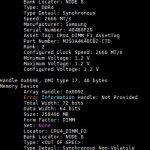
INSTALL WINDOWS ON OPTANE DC PERSISTENT MEMORY KEYGEN

Its role is to bridge the gap between storage and traditional memory and to enable affordable, large-scale memory deployments.ĢCPUs+6 DRAM modules+6 DCPMMs Why Use Intel Optane DC Memory? Intel Optane DC (Data Center) Persistent Memory (DCPMM) is a memory module that gets slotted into the server’s DIMM slots. Optane Persistent Memory for Data Centers Inadequate hardware makes it difficult to maintain consistent quality-of-service. More data is available than ever before in both volume and value. It caches frequently accessed files in a non-volatile manner, thus speeding up system responsiveness.īusinesses often delay upgrading their server equipment due to prohibitive costs. Instead, its purpose is to complement and improve existing memory configurations.īy combining the speed of short-term working memory (DRAM), with the persistent quality of Intel Optane, you get a responsive system that can access data faster with a higher level of reliability.įor example, a 32 GB stick of M.2 Optane memory can accelerate any SATA-based storage drive. It is important not to think of Intel Optane as a replacement for standard DRAM. To make use of Optane’s speed and performance, Optane SSDs use the NVMe interface which is superior to SATA.Īs prices drop, Optane SSDs will become an integral part of every modern consumer PC. More and more organizations are using Optane SSDs for sensitive data center workloads. Such performance is highly coveted in enterprise use cases. Hence, vendors usually speak of maximum theoretical IOPS scores.įurthermore, Optane is considered highly reliable, with fewer dips in performance and lower latency. IOPS may differ from one workload to another. It stands for “inputs/outputs per second” and is calculated in integers. Note: IOPS is a measurement for drive performance. Its advantage over other high-performance SSDs is less pronounced when it comes to write-intensive workloads. Tests have shown that Intel Optane is better for applications with read-intensive access patterns. Optane performs excellent, with up to 550,000 IOPS and 500,000 IOPS in 4K random reads and writes. Its speed is comparable to RAM and yet it is non-volatile, thus it can retain data for a long time. Optane technology is an excellent candidate to replace NAND SSDs. Tests have shown that Intel Optane can endure up to six times more DWPD than traditional NAND SSDs when write-intensive workloads are applied. Excellent storage endurance is one of the reasons why Intel Optane excels in in-memory database deployment. An immensely important feature for enterprise write workloads. This number represents how many times the drive’s entire storage can be overwritten each day of its life. Intel claims that the read response times are continuously below 30 microseconds while maintaining a 70% read and 30% write workload.ĭue to the unique technology used, Intel Optane has a very high endurance of up to 60 Drive Writes per Day (DWPD).

Even with extremely heavy loading scenarios, Optane can still ensure latency meets the requirements for latency-critical applications. Read speeds are consistently high, even with multiple write operations running in parallel. Low latency is one of Intel Optane’s best features. Slower than DRAM, but much faster than flash memoryĬosts less than DRAM but more than flash memoryĮxcellent read response times compared to flash-based drives However, let us outline the fundamental differences between Intel Optane Memory, SSDs, and DRAM to pinpoint its strong points. Due to that factor alone, it would not make much sense to use it as a primary memory device. Intel Optane Vs SSD Vs DRAM: Performance ComparisonĪs expected, Intel Optane Memory is not faster than DRAM memory. Despite initial market skepticism, in subsequent years, Intel’s Optane range became widely implemented on an enterprise level and in dedicated servers.


 0 kommentar(er)
0 kommentar(er)
